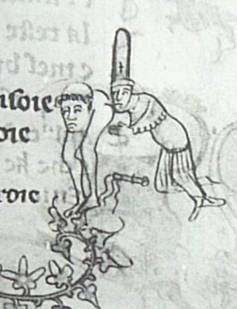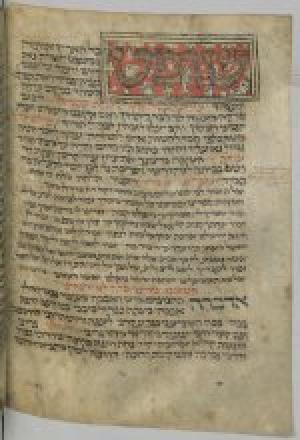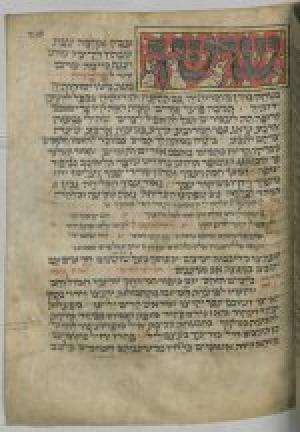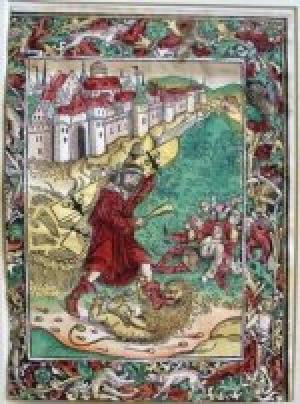Obj. ID: 4094
Hebrew Illuminated Manuscripts Hybrid Ashkenazi Mahzor, Franconia, third quarter of the 13th c.

The Mahzor for whole year, probably intended for the use of a cantor in the synagogue, is according to the eastern Ashkenazi rite, widely used in the territories east of theRhine(Fleischer 2008, p. 6). It opens with prayers for the Special Sabbaths which fall before and after Purim and ends with the piyyutim for Hanukkah.
The Mahzor belongs to the abbreviated version of early Ashkenazi mahzorim which comprised the piyyutim, entirely omitting the usual prayers and the readings from the Torah, Prophets and the Megillot (Fleischer 1985, p. 36).
The text of the Mahzor is not commented upon, except for the commentary accompanying the Aramaic piyyutim for Shavuot (fols. 76v-86v), and it does not include ritual instructions, except for those preceding the Passover Seder (fol. 21).
The decoration programme of our manuscript follows the pattern found in many other Ashkenazi mahzorim from the 13th century onwards, for example in the Michael Mahzor (Oxford, Bodl. Lib. Mich. 617) produced inFranconiain 1258. The initial words opening the yozrot, and also those opening some other sections, are enclosed within rectangular panels decorated with various motifs which are mostly unrelated to the text.
The text was copied and vocalised by a single scribe, who also wrote well as the initial words in display script. Some omitted initial words were added by hands emulating the scribe (fols. 275 and 280). In the first three quires the scribe decorated the initial words using a saw-tooth motif and wrigglework (fols. 4 - fig. 4, 6v, 9, 17). The rest of the manuscript was decorated by five illuminators, except for the initial word on
fol. 35 (fig. 3) which remained undecorated.
In contrast to the scribal decoration, the illuminators enclosed the initial words within framed panels and decorated them, mainly with dragons, fish, hybrids and birds. They preserved the main features of the scribe's initial letters: the shape of א (aleph), joining the left stem of ה (hei) to its roof and adding roundels in the middle of the letters' stems. On the other hand, some words were partly covered by a panel (fol. 213v-
fig. 9) or by the ascender of a ל (lamed; fol. 177 – fig. 8); even the vocalisation of the initial words was rendered barely visible because of the colours, and therefore Illuminator D added it below the panels he painted (fols. 162, 177 – fig. 8).
The main stylistic differences between the five illuminators are found in their compositions, range of colours, and treatment of letters, as well as the execution of the decorative motifs.
The two panels of Illuminator A (fols. 12, 263 – figs. 5, 14) are unframed and decorated with a dragon, dog, heraldic eagle, lion and ox in spared-ground technique, also within the letters of the second panel. The acanthus scrolls springing from either a tail of a dragon or a lion split into elongated leaves divided into three lobes. The colours are blue for the panel and red for the letters.
The compositions of Illuminator B (fols. 25 – fig. 6; 31, 68v - fig. 10) are denser than those of the other illuminators: the dragons and fish are large, detailed and connected with each other. In between appear a monkey, a double-headed bird, a bucranium and a dog. The border consists of two freehand lines: the inner is in black ink; the outer, in brown, was added during colouring. The acanthus scrolls which emerge from the mouths of the creatures split into rounded, serrated leaves. The colours are yellowish for the panel, and green and magenta for parts of the motifs, which are mostly in spared-ground technique.
Illuminator C (fols. 39 – fig. 7, 50, 91v) inserts his human hybrids, dragons and bucranium motifs between the letter stems. The scroll of rounded, serrated leaves surrounds the composition and fills the spaces. The background colours and motifs have a few elements in spared-ground technique and the letters are in silver on a brown ground. The ruled double frame is in black ink and uncoloured.
Illuminator D (fols. 162, 177 – fig. 8) draws only a few large motifs between the stems of the letters, such as a dragon and fish or human and animal hybrids. His style recalls that of Illuminator A but the composition is more spacious and framed by an acanthus scroll with three-lobed leaves. The ground is green, mostly washed off, whereas the motifs are in spared-ground technique. The letters are in silver, mostly flaked off to show the brown ground. The ruled double frame is in black ink and uncoloured.
Illuminator E (fols. 123, 189, 191a, 213v – fig. 9; 218, 239v, 250 and 270v) has the most spacious compositions. His motifs are fish, birds or bird and animal heads. He uses simple three-lobed segments of flowers as fillers, mostly attached to the frame. The motifs have a clear, wide ink outline and are sparsely articulated. They are in spared-ground technique, mostly on a red ground, but also on a washed-off green and parchment ground, with yellow, red or green frames. The letters are in flaked-off silver, revealing the brown ground.
It seems that the similar though distinguishable hands who decorated the manuscript were randomly allotted different quires. Illuminator A received quires II and XXXVII; Illuminator B quires IV, V and IX; Illuminator C quires VI, VII and XII; Illuminator D quires XXIII and XXIV; and Illuminator E quires XVI, XXVI, XXVII, XXIX, XXXI, XXXIII, XXXV and XXXVIII. In addition the text scribe decorated four initial words in quires I-III.
|
Fig. 3: Initial word Hybrid Ashkenazi Mahzor Munich, BSB Cod.hebr. 21, fol. 35
Fig. 4: Initial word by the text scribe Hybrid Ashkenazi Mahzor Munich, BSB Cod.hebr. 21, fol. 4 Fig. 5: Initial word panel by Illuminator A Hybrid Ashkenazi Mahzor Munich, BSB Cod.hebr. 21, fol. 12
Fig. 6: Initial word panel by Illuminator B Hybrid Ashkenazi Mahzor Munich, BSB Cod.hebr. 21, fol. 25 |
Fig. 7: Initial word panel by Illuminator C Hybrid Ashkenazi Mahzor Munich, BSB Cod.hebr. 21, fol. 39
Fig. 8: Initial word panel by Illuminator D Hybrid Ashkenazi Mahzor Munich, BSB Cod.hebr. 21, fol. 177
Fig. 9: Initial word panel by Illuminator E Hybrid Ashkenazi Mahzor Munich, BSB Cod.hebr. 21, fol. 213v |
The dating and localisation of our manuscript can be established by comparison with the Laud Mahzor
(fig. 11) and Michael Mahzor (fig. 13). The style of Illuminator B, especially in his animal heads, is similar to that of the artist of the Laud Mahzor (cf. figs. 10-11). The heads depicted in profile are flattened, with a wide mouth and big eyes under a long eyebrow. The forehead is short and convex, and they have small, rounded ears.
|
Fig. 10: Initial word by Illuminator B Hybrid Ashkenazi Mahzor Munich, BSB Cod.hebr. 21, fol. 68v
|
Fig. 11: Laud Mahzor Franconia, c.1260 Oxford, Bodl. Lib. Laud Or. 321, fol. 165v (Jerusalem, CJA Documentation) |
|
Fig. 12: Initial word panel by Illuminator C Hybrid Ashkenazi Mahzor Munich, BSB Cod.hebr. 21, fol. 91v
|
Fig. 13: Initial word panel Michael Mahzor Franconia, 1258 Oxford, Bodl. Lib.Mich.617, fol. 52 (Jerusalem, CJA Documentation) |
In spite of these similarities, the composition of the panels in the Laud Mahzor and our manuscript is not very similar. A closer example is found in the Michael Mahzor (fig. 13). Its panels are decorated with similar motifs such as dragons, fish, heraldic eagles and animals which are placed within the letters and the frame, similarly to our Mahzor, while the scroll on the upper part of the panel creates an additional border
(cf. figs. 12-13).
|
Fig. 14: Initial word panel by Illuminator A Hybrid Ashkenazi Mahzor Munich, BSB Cod.hebr. 21, fol. 263
|
Fig. 15: Initial word Laud Mahzor Franconia, c.1260 Oxford, Bodl. Lib. Laud Or. 321, fol. 171 (Jerusalem, CJA Documentation) |
|
Fig. 16: Initial letter Graduale Ordinis Praedicatorum St. Katharinental, 1312 Zurich, Landesmuseum (olim Malvern), Dyson Perrins Coll., Ms 128, fol. 194 (Beer 1959, pl. 17, fig. 23) |
|
The letters decorated with dragons and acanthus scrolls in spared-ground technique (fig. 14) likewise appear in the Laud and Michael Mahzorim (fig. 15). However, in Latin manuscripts of German origin this type of decoration in spared-ground technique within letters appears about half a century later. Its earliest examples, such as the Graduale Ordinis Praedicatorum from St. Katharinental dated 1312 (fig. 16), are from theUpper Rhine region (see Beer 1959: Kat. Nos. 20, 23, 30), in contrast to Hebrew manuscripts which are mainly of Franconian origin.
 |
 |
 |
 |
|
Fig.17: Head between legs Hybrid Ashkenazi Mahzor Munich, BSB Cod.hebr. 21, fol. 177 |
Fig. 18: Head between legs Hybrid Ashkenazi Mahzor Munich, BSB Cod.hebr. 21, fol. 39
|
Fig. 19: Head between legs Jacques de Longuyon: Voeux du Paon Franco-Flemish mid-14th century New York, PML Glazier 24, fol. 93 (Randall 1966, pl. CXI, fig. 536) |
Fig. 20: Head between legs Biblia Latina Engelberg, c.1400-1420 Engelberg, Stiftsbibliothek Cod. 6, fol. 102v (Jerusalem, CJA Sed-Rajna Archive) |
Other motifs, especially outstanding ones such as that of a head between two legs (figs. 17, 18), are found in later Latin manuscripts. One example is a Franco-Flemish codex of the mid-14th century and another
from Engelberg at the beginning of the 15th century (figs. 19, 20). Originating apparently in Bestiaries and Marvels of the East (Wittkover 1942: 159-197; Randall 1957: 97-107), such motifs often appear in the margins or around initial letters.
In order to date our manuscript, its codicological features should also be considered: the pricking in the outer margins only and the ruling by stylus point to a transitional period for these techniques occurring during the second half of the 13th century (Beit-Arié 1976:22-25, 70-71, 74).
sub-set tree:
Text space: (252-254) x (182-185) mm.
|
Fig. 1: Front cover with pigskin strip of 70 mmwide Hybrid Ashkenazi Mahzor Munich, BSB Cod.hebr. 21 |
Fig. 2: Back cover, strip of c.70 mm wide (detail) Red Dragon Pentateuch Munich, BSB Cod.hebr. 14 |
15th-century binding (fig. 1). The spine and part of the wooden boards (345 x245 mm) are covered with a strip of white pigskin (width: 70 mm) decorated with a blind-tooled chain of floral ornament (fig. 2). The spine has three double cords and head and tail bands. Holes and the remnants of nails are situated along the upper and lower edges of the front cover and denote the place of two clasps. They correspond to the carved squares on the back cover where the straps were attached.
The binding was probably done in the Augustinian Eremiten monastery of St. Vitus inNuremberg(Munich, EBDB p001297; Hernad 1990:66; Kyriss 1951/58, No. 19).
This binding is similar to that of other Hebrew manuscripts from Harmann Schedel's collection (see History: also CJA Documentations of BSB Cod.hebr. 14 - fig. 2; Cod.hebr. 69 and 90).
The decoration was executed by the scribe and five illuminators (see: Remarks):
- Text illustration of the Gate of Mercy by Illuminator E opening the first benediction before the morning Shema for the Day of Atonement (fol. 191a).
- Initial word panels by Illuminators A-D opening yozrot and other piyyutim are decorated with fish, birds, dragons, other creatures and floral motifs (fols. 12, 25, 31, 39, 50, 68v, 91v, 123, 162, 177, 189, 191a, 213v, 218, 239v, 250, 263, 270v).
- Initial words by the scribe opening the yozrot are surrounded by wrigglework and decorated with a red and green saw-tooth motif and stripes (fols. 4, 6v, 9, 17 and). Some of the smaller initial words, mostly opening other piyyutim such as ofan and zulat, are written in red or red and black ink on a dotted rectangular ground (e.g. fols. 3v, 4v, 8).
- Smaller initial and other words, sometimes even sentences on almost every page are written in red, blue or green.
Note: Green folio number denotes it is described under "Illuminated Documents".





































